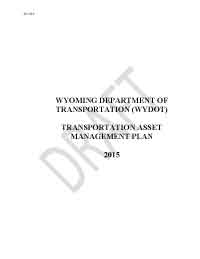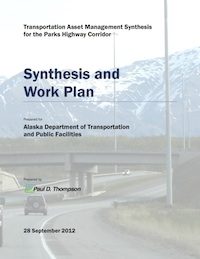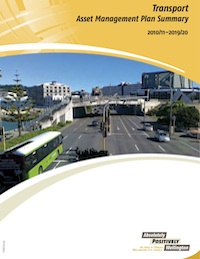Plan Characteristics Presents a corridor view of asset management
The Wyoming DOT – TAMP [DRAFT] is available here.
This document meets the following additional criteria: • Includes analysis of future demand impacts on asset needs • Key revenue projection assumptions identified • Presents a corridor view of asset management.
The modal scope of this document is: Highway Only.
The asset scope of this document is: Highway Assets, Pavement and bridge only.
External link:
This document is a draft of the Wyoming DOT TAMP. The final version was published in 2018 and can be viewed here:
https://www.tamptemplate.org/tamp/039_wyomingdot/
The Wyoming TAMP presents the DOT's approach to managing its pavement and bridge assets. The TAMP includes sections on pavement and bridge conditions and programs, life cycle cost analysis, financial planning and investment strategies, and risks to the transportation system.
The Alaska DOT&PF – Transportation Asset Management Synthesis for the Parks Highway Corridor is available here.
This document meets the following additional criteria: • Asset valuation included • Future cost/performance projections are based on management system analysis (e.g. HERS, dTIMS) • Includes an assessment of data quality or reliability • Includes cross-asset resource allocation method • Includes customer-oriented LOS statements • Presents a corridor view of asset management.
The modal scope of this document is: Highway Only.
The asset scope of this document is: Highway Assets, Includes other highway assets.
External link: http://www.dot.state.ak.us/stwddes/asset_mgmt/assets/enterprise_tam_workplan_final.pdf
Alaska DOT & PF seeks to develop their agency's asset management maturity in order to improve the life cycle management and performance of their resources. The TAMP addresses a desire to more effectively use rich collections of data, fill gaps in data and understanding of performance, and change organizational procedures and culture. This TAMP outlines a work plan for the timeframe of 2012-2014, composed of self-contained projects for the advancement of the agency's current practice.
The New Zealand Transport Agency – State Highway Asset Management Plan is available here.
This document meets the following additional criteria: • Asset valuation included • Includes an assessment of data quality or reliability • Includes analysis of future demand impacts on asset needs • Includes estimates of future maintenance costs • Includes formal risk assessment results such as a risk register • Includes future projected asset condition • Includes substantive list of process, data, and/or systems improvement actions • Investment strategies summarize planned capital and operating expenditures • Presents a corridor view of asset management.
The modal scope of this document is: Highway Only.
The asset scope of this document is: Highway Assets, Includes other highway assets.
External link: http://www.nzta.govt.nz/resources/state-highway-asset-management-plan/docs/state-highway-asset-mgmt-plan-2012-2015.pdf
The Asset Management Plan includes a framework for the document that depicts each section and the relationship to other sections and to the plan as a whole. Sections include descriptions of the agency assets, programs, demand, performance, risk, prioritization processes, improvements, implementation, and the link between existing plans. The AMP also includes a statement of intent, covering a list of desired impacts, with key progress indicators and targets for the agency.


